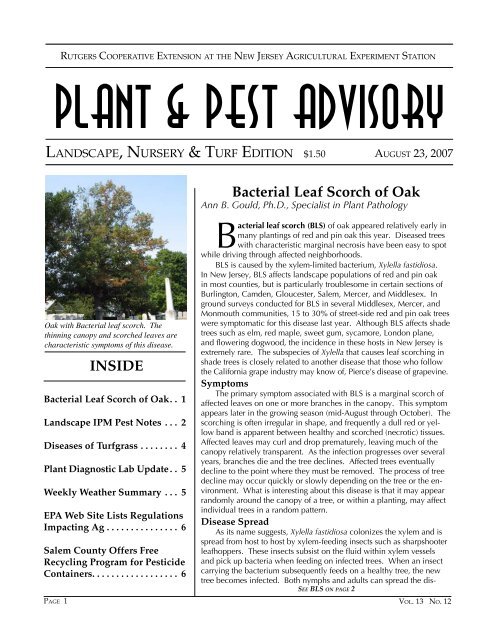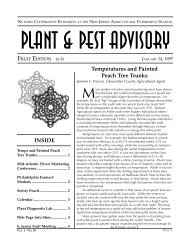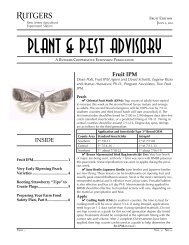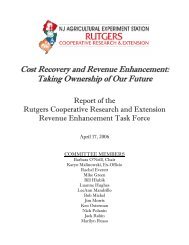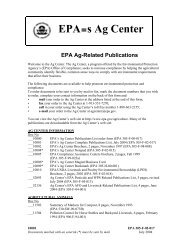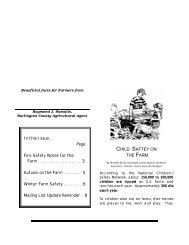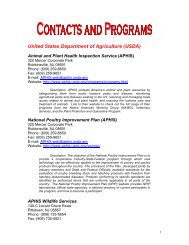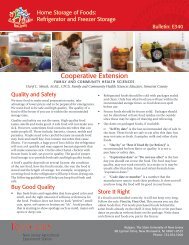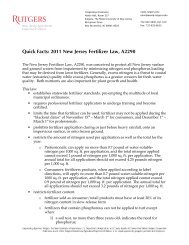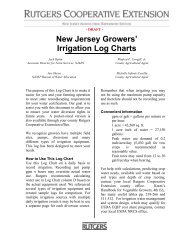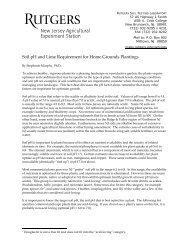INSIDE Bacterial Leaf Scorch of Oak - Rutgers New Jersey ...
INSIDE Bacterial Leaf Scorch of Oak - Rutgers New Jersey ...
INSIDE Bacterial Leaf Scorch of Oak - Rutgers New Jersey ...
Create successful ePaper yourself
Turn your PDF publications into a flip-book with our unique Google optimized e-Paper software.
uTgers cooPeraTiVe exTeNsioN aT The <strong>New</strong> <strong>Jersey</strong> agriculTural exPerimeNT sTaTioN<br />
Plant & Pest advisory<br />
laNdscaPe, Nursery & Turf ediTioN $ .50 augusT 23, 2007<br />
<strong>Oak</strong> with <strong>Bacterial</strong> leaf scorch. The<br />
thinning canopy and scorched leaves are<br />
characteristic symptoms <strong>of</strong> this disease.<br />
<strong>INSIDE</strong><br />
<strong>Bacterial</strong> <strong>Leaf</strong> <strong>Scorch</strong> <strong>of</strong> <strong>Oak</strong> . . 1<br />
Landscape IPM Pest Notes . . . 2<br />
Diseases <strong>of</strong> Turfgrass . . . . . . . . 4<br />
Plant Diagnostic Lab Update . . 5<br />
Weekly Weather Summary . . . 5<br />
EPA Web Site Lists Regulations<br />
Impacting Ag . . . . . . . . . . . . . . . 6<br />
Salem County Offers Free<br />
Recycling Program for Pesticide<br />
Containers . . . . . . . . . . . . . . . . . . 6<br />
<strong>Bacterial</strong> <strong>Leaf</strong> <strong>Scorch</strong> <strong>of</strong> <strong>Oak</strong><br />
Ann B. Gould, Ph.D., Specialist in Plant Pathology<br />
<strong>Bacterial</strong> leaf scorch (BLS) <strong>of</strong> oak appeared relatively early in<br />
many plantings <strong>of</strong> red and pin oak this year. Diseased trees<br />
with characteristic marginal necrosis have been easy to spot<br />
while driving through affected neighborhoods.<br />
BLS is caused by the xylem-limited bacterium, Xylella fastidiosa.<br />
In <strong>New</strong> <strong>Jersey</strong>, BLS affects landscape populations <strong>of</strong> red and pin oak<br />
in most counties, but is particularly troublesome in certain sections <strong>of</strong><br />
Burlington, Camden, Gloucester, Salem, Mercer, and Middlesex. In<br />
ground surveys conducted for BLS in several Middlesex, Mercer, and<br />
Monmouth communities, 15 to 30% <strong>of</strong> street-side red and pin oak trees<br />
were symptomatic for this disease last year. Although BLS affects shade<br />
trees such as elm, red maple, sweet gum, sycamore, London plane,<br />
and flowering dogwood, the incidence in these hosts in <strong>New</strong> <strong>Jersey</strong> is<br />
extremely rare. The subspecies <strong>of</strong> Xylella that causes leaf scorching in<br />
shade trees is closely related to another disease that those who follow<br />
the California grape industry may know <strong>of</strong>, Pierce’s disease <strong>of</strong> grapevine.<br />
Symptoms<br />
The primary symptom associated with BLS is a marginal scorch <strong>of</strong><br />
affected leaves on one or more branches in the canopy. This symptom<br />
appears later in the growing season (mid-August through October). The<br />
scorching is <strong>of</strong>ten irregular in shape, and frequently a dull red or yellow<br />
band is apparent between healthy and scorched (necrotic) tissues.<br />
Affected leaves may curl and drop prematurely, leaving much <strong>of</strong> the<br />
canopy relatively transparent. As the infection progresses over several<br />
years, branches die and the tree declines. Affected trees eventually<br />
decline to the point where they must be removed. The process <strong>of</strong> tree<br />
decline may occur quickly or slowly depending on the tree or the environment.<br />
What is interesting about this disease is that it may appear<br />
randomly around the canopy <strong>of</strong> a tree, or within a planting, may affect<br />
individual trees in a random pattern.<br />
Disease Spread<br />
As its name suggests, Xylella fastidiosa colonizes the xylem and is<br />
spread from host to host by xylem-feeding insects such as sharpshooter<br />
leafhoppers. These insects subsist on the fluid within xylem vessels<br />
and pick up bacteria when feeding on infected trees. When an insect<br />
carrying the bacterium subsequently feeds on a healthy tree, the new<br />
tree becomes infected. Both nymphs and adults can spread the dis-<br />
See BLS on page 2<br />
Page Vol. 3 No. 2
BLS from page 1<br />
ease; adults remain infective for the<br />
remainder <strong>of</strong> their life, nymphs are<br />
infective only until their next molt.<br />
Diagnosis<br />
Symptoms <strong>of</strong> BLS are very similar<br />
to those caused by agents such as<br />
moisture stress and excessive salt. It<br />
is not surprising, therefore, that the<br />
disease is frequently misdiagnosed.<br />
To diagnose this disease, submit<br />
a small branch specimen (pencilwidth<br />
in diameter), with scorched<br />
leaves attached, to the <strong>Rutgers</strong> Plant<br />
Diagnostic Laboratory for analysis;<br />
do not wrap the sample in plastic.<br />
The laboratory will identify<br />
BLS through the use <strong>of</strong> a selective<br />
antibody (ELISA) technique. Proper<br />
sampling is necessary for an accurate<br />
diagnosis; the best samples have<br />
leaves that are symptomatic for the disease.<br />
For more information on mailing<br />
and fees, see the following link:<br />
http://njaes.rutgers.edu/plantdiagnosticlab/<br />
or see Turf Disease article on page 4<br />
for further contact information.<br />
Management<br />
Care-takers <strong>of</strong> the <strong>New</strong> <strong>Jersey</strong><br />
urban forest should look for<br />
the canopy thinning and marginal<br />
scorch characteristic <strong>of</strong> BLS from<br />
now through mid-October. Since<br />
there is no cure for this disease,<br />
proper management strategy includes<br />
the maintenance <strong>of</strong> tree vigor<br />
for as long as possible. If possible,<br />
water affected trees during times <strong>of</strong><br />
water stress to reduce the debilitating<br />
affects <strong>of</strong> this disease. In addition,<br />
other diseases, insects, and<br />
environmental stresses (including<br />
drought) enhance the development<br />
<strong>of</strong> BLS. Branches and infected trees<br />
in a severe state <strong>of</strong> decline should be<br />
routinely removed as they are potential<br />
hazards. Expensive tree injections<br />
reduce symptom development,<br />
but do not cure the disease and must<br />
be repeated. In areas known to be<br />
affected by this disease, replace affected<br />
trees with species that are not<br />
known hosts <strong>of</strong> the bacterium. o<br />
Landscape IPM Pest Notes<br />
Steven K. Rettke, Ornamental IPM Program Associate<br />
4 PRAYING MANTIDS: Are They Valuable Landscape Predators?<br />
Contrary to popular belief, these well known predators do not have a significant<br />
impact towards the suppression <strong>of</strong> any key landscape pests. Praying<br />
mantids are generalist predators and should not be promoted to clients<br />
as viable control agents in the landscape or garden. They are indiscriminate<br />
feeders and will consume both pest and beneficial insects, including<br />
honeybees, ladybeetles, butterflies, and lacewings. Furthermore, they are<br />
cannibalistic and highly territorial. As these insects molt/grow and develop<br />
during the season, it is rare for them to maintain their numbers at densities<br />
high enough to contribute to major biological controls in the landscape.<br />
An old urban myth, apparently sometimes promoted by elementary<br />
school children, is that state laws protect praying mantids. There have<br />
never been any <strong>of</strong>ficial state laws protecting this insect anywhere in the<br />
country. However, the destruction <strong>of</strong> this insect is not being endorsed<br />
when observed. Its only crime is that they have incorrectly been awarded<br />
high status as valuable predators.<br />
4 ANTS & HONEYDEW PRODUCERS vs. PREDATORS: Various pests<br />
such as aphids, s<strong>of</strong>t scales, mealybugs, and whiteflies are plant feeders that<br />
insert their piercing-sucking mouthparts into vascular tissue (phloem) to remove<br />
plant sap from leaves or stems. Since phloem sap is not nutrient rich<br />
in proteins, plant pests must withdraw large quantities to maintain growth<br />
and reproduction. As a result, to avoid blowing-up into “Macy’s Thanksgiving<br />
Day Balloon Floats” these insects must also expel copious amounts<br />
<strong>of</strong> unwanted waste called honeydew. The predigested honeydew still contains<br />
a lot <strong>of</strong> sugary carbohydrates and is valued by ants, wasps, bees and<br />
other vespids as a food source. The honeydew is <strong>of</strong>ten easily observed as a<br />
clear, shiny and sticky material on foliage. The honeydew usually darkens<br />
over time as a black sooty mold fungus grows on the liquid droppings.<br />
Numerous predators and parasitoids including ladybeetles, lacewings,<br />
flower flies and wasp parasites typically attack and consume honeydewproducing<br />
pests. Carpenter ants and other colony ant species have waged<br />
vicious wars for “eons” against predators <strong>of</strong> honeydew producers. Certain<br />
ant species will expend a lot <strong>of</strong> energy and effort to protect honeydew producers<br />
and prevent effective biological control. As a result, to help restore<br />
the predator vs. prey balance in the landscape, it may be necessary for<br />
the pest manager to intervene and seek out ant colony locations to apply<br />
controls.<br />
4 SYMPTOMS vs. SIGNS: Occasionally plant diagnosticians will<br />
mistakenly use symptoms and signs interchangeably when describing plant<br />
problems. It is important to distinguish the difference in meaning when<br />
describing each term. Being consistent when communicating plant diagnostics<br />
will help reduce confusing an already complicated process.<br />
Symptoms can be defined as the abnormal appearance <strong>of</strong> a plant after<br />
successful pest attack (e.g., stippling, defoliation, skeletonization, notching,<br />
chlorosis, necrosis, etc.). A common error arborists sometimes make<br />
is classifying woodborer exit holes as signs. In actuality it is proper to call<br />
them symptoms.<br />
Alternatively, signs can be defined as the actual presence <strong>of</strong> the pest<br />
(the causal agent) or pest related byproducts (e.g., active insects, mites, or<br />
cast skins, eggs, webbing, honeydew, sooty mold, fruiting bodies, mycelium,<br />
etc.). For example, since signs are observed causal agents, it would<br />
be correct to call tree damaging girdling roots as signs.<br />
See Ipm peSt noteS on page 3<br />
Page 2 Vol. 3 No. 2
Ipm peSt noteS from page 2<br />
4 OBSCURE SCALE (1500-2500 GDD = crawlers):<br />
An armored scale that is an important landscape pest <strong>of</strong><br />
oaks (especially pin oaks or other red oak group species).<br />
This scale should be listed as a key pest <strong>of</strong> oaks.<br />
It will also be found on dogwood, willow, chestnut,<br />
maple, hickory, and beech. As the common name <strong>of</strong><br />
this pest implies, it is not easy to observe obscure scales.<br />
Even highly experienced arborists <strong>of</strong>ten do not recognize<br />
the symptoms or signs <strong>of</strong> this scale species.<br />
Initially inspect 3 to 4 year old wood when scouting<br />
for the presence <strong>of</strong> obscure scales. When grouped together<br />
in large numbers, they <strong>of</strong>ten cause sunken areas<br />
on branches or trunks similar to cankers. The scale covers<br />
are circular (1/10 to 1/8 inches in diameter) and its<br />
silvery gray to dirty gray coloration <strong>of</strong>ten blend in well<br />
on bark. This species does not feed on foliage. Although<br />
there is only one generation per year, the crawler<br />
emergence period extends for 2 months or longer. Early<br />
egg hatch begins in July, but crawlers can continue to<br />
emerge into the middle <strong>of</strong> September. The early season<br />
crawlers typically settle beneath old, dead scale covers<br />
to feed. The later season crawlers will usually settle<br />
within non-infested bark areas.<br />
Controls: The extended crawler period, waxy<br />
cover, and settling behavior under the protection <strong>of</strong> old,<br />
dead scale covers all complicate the control <strong>of</strong> obscure<br />
scales. They overwinter as yellow, immature nymphs.<br />
The use <strong>of</strong> dormant horticultural oils will not provide<br />
satisfactory suppression, because <strong>of</strong> the protective waxy<br />
cover. As a result, it is important to target the vulnerable<br />
crawlers with insecticides during the July, August,<br />
September months. Summer oil sprays applied to<br />
infested branches and trunk will provide good controls<br />
if adequate coverage is achieved. However, because<br />
<strong>of</strong> the long crawler emergence, multiple applications<br />
will be required (usually 2 or more sprays). To reduce<br />
applications the addition <strong>of</strong> a pyrethroid may be suggested.<br />
However, if many holes in covers are observed,<br />
then this indicates the presence <strong>of</strong> beneficial parasitoid<br />
wasps. Pyrethroids are highly detrimental to parasitoids/predators<br />
and will eliminate them from the area for<br />
many weeks. Consider not using pyrethroids if beneficials<br />
are numerous.<br />
4 SAFARI (Dinotefuran)=A Promising <strong>New</strong> Armored<br />
Scale Control: Unlike Merit, the new neonicotinoid<br />
insecticide named Safari (dinotefuran) is showing<br />
promise as an effective control against armored scales.<br />
Although both Safari and Merit (imidacloprid) have<br />
systemic capabilities with the same general mode <strong>of</strong><br />
action, Safari is significantly more water-soluble. The<br />
high water solubility is thought to be the reason for the<br />
increased armored scale controls.<br />
Armored scales primarily feed by inserting their<br />
piercing-sucking mouthparts into parenchyma cells containing<br />
chlorophyll. Since Merit predominately moves<br />
through plants by vascular tissues (phloem and xylem),<br />
it does not readily enter into cells where armored scales<br />
feed. Consequently, Merit has not shown good efficacy<br />
against pests that feed within plant cells (typically less<br />
than 30-40% control).<br />
Recent University efficacy trials have shown dramatically<br />
improved results against armored scales with<br />
soil injection or drench applications <strong>of</strong> Safari insecticide.<br />
Although this material continues to be translocated<br />
by vascular tissues, it also appears to have the ability<br />
to permeate through cell walls and membranes. Some<br />
early efficacy trials have shown controls exceeding<br />
80%! Additional efficacy trials will substantiate these<br />
early results.<br />
4 PITCH MASS BORERS and LACBALSUM<br />
WOUND DRESSING: Pitch Mass Borers are wood<br />
boring caterpillars. As adults they are called clearwing<br />
moths and are in the same family with lilac borers,<br />
rhododendron borers, peachtree borers, banded ash borers,<br />
dogwood borers, as well as others. Pitch mass borer<br />
adults are “on the wing” during the months <strong>of</strong> June and<br />
July and typically deposit eggs near wounds on several<br />
different pine and spruce species. The usual pine trees<br />
attacked include Austrian, Scotch, and eastern white.<br />
The common spruce trees attacked include Norway,<br />
white, and Colorado blue.<br />
The pitch mass borer is primarily a nuisance in<br />
home landscapes or public park areas. Rarely do these<br />
borers create a plant health concern by girdling trunks<br />
or branches. They will take 2 to 3 years to mature and<br />
feed within the inner bark and outer sapwood. However,<br />
these shallow tunneling caterpillars do produce<br />
copious amounts <strong>of</strong> pitch. This pitch can potentially rain<br />
down on picnic tables, backyard decks or parked cars.<br />
The pitch mass borer, as well as all clearwing<br />
moths, requires a wound to successfully penetrate and<br />
bore into a tree. Therefore, pitch mass borer attacks will<br />
<strong>of</strong>ten increase after pruning wounds are made (proper<br />
pruning cuts included). Several years ago, some studies<br />
performed by Cornell University researchers unintentionally<br />
showed that pitch mass borer attacks could be<br />
reduced on recently pruned pines or spruces by applying<br />
a wound dressing. They applied a new generation<br />
wound dressing called Lacbalsum (has a flat gray color)<br />
over the fresh pruning cuts. The conifers receiving the<br />
wound dressing showed no evidence <strong>of</strong> pitch mass borer<br />
infestations after 2 years. Apparently the Lacbalsum<br />
acted as a protective barrier and/or did not attract egg<br />
deposition. On the other hand, 30% <strong>of</strong> the conifers not<br />
receiving the wound dressing showed evidence <strong>of</strong> pitch<br />
mass borer activity one or two years later (Note: proper<br />
experimental protocol was not followed in determining<br />
these results).<br />
Actually the goal <strong>of</strong> the Cornell research was to determine<br />
the health affects on conifers after applying the<br />
new Lacbalsum wound dressing. A couple <strong>of</strong> decades<br />
ago, the late Dr. Alex Shigo had made a strong case<br />
against the use <strong>of</strong> some tested wound dressings, demonstrating<br />
that they increased wood decay. Although<br />
the Lacbalsum wound dressing did not decrease wood<br />
decay in the pruning cut areas, the study also showed it<br />
did not increase wood decay either. Therefore, the Cornell<br />
research indicated that this new generation wound<br />
dressing could be safely used to improve the aesthetics<br />
after pruning without harming conifer trees. o<br />
Page 3 Vol. 3 No. 2
Diseases <strong>of</strong> Turfgrass<br />
Bruce B. Clarke, Ph.D., Specialist in Turfgrass<br />
Pathology<br />
General<br />
Dollar spot has redeveloped on golf and landscape<br />
turf due to the recent cool, wet weather (August 18-23,<br />
2007). Expect this disease to continue to be a problem<br />
through October. Copper spot, summer patch, fairy<br />
ring, slime mold and anthracnose are also active at this<br />
time. Pythium and brown patch can still be troublesome<br />
if the hot, humid weather returns so maintain<br />
preventive sprays. Refer to recent issues <strong>of</strong> this newsletter<br />
for further disease control information.<br />
Gray <strong>Leaf</strong> Spot<br />
Gray leaf spot, caused by the fungus Pyricularia<br />
oryzae, is really starting to intensify on susceptible<br />
perennial ryegrass overseedings. This disease has<br />
devastated many new perennial ryegrass and tall fescue<br />
plantings throughout the Mid-Atlantic States over the<br />
past few years. Symptoms start as tiny, brown leaf<br />
and stem lesions within a 1 to 2 inch patch. In severe<br />
cases, the leaves twist and curl in a “J-shape” and lesions<br />
may extend the entire width <strong>of</strong> the blade. As the<br />
disease progresses, patches coalesce into large (1 to 2 ft<br />
diameter) areas <strong>of</strong> blighted turf. Extensive foliar blighting<br />
may occur during warm (70-85 0 F days and 60-75 o<br />
F nights), wet weather. <strong>New</strong>ly established seedings are<br />
more susceptible to infection than mature plantings, so<br />
be sure to use a mixture <strong>of</strong> perennial ryegrass cultivars<br />
with improved resistance to Gray <strong>Leaf</strong> Spot (e.g., 1G 2 ,<br />
1G2, All*Star 3, Apple GL, Charismatic II GLSR, Dart,<br />
Derby Xtreme, DP-1, (Soprano) Exacta II GLSR, Fiesta<br />
4, GL-2, Harrier, Manhattan 5 GLR, Palace, Palmer<br />
IV, Palmer GLS, Palmer V, Panther GLS, Paragon GLR,<br />
Prelude GLS, Primary, Protégé GLR, Regala 5, Repel<br />
GLS, Revenge GLX, Secretariat II GLSR, SR 4600, and<br />
Stellar GL) when overseeding or establishing new areas.<br />
When conditions are conducive to disease development<br />
the pathogen produces abundant one to two-celled,<br />
pear-shaped spores (conidia). To suppress this disease,<br />
avoid high rates <strong>of</strong> nitrogen (i.e., do not apply more<br />
than 0.25 lb N per 1,000 sq ft) during July and August<br />
and avoid extended periods <strong>of</strong> leaf wetness (i.e., do not<br />
water between 6 PM and midnight). Fungicide studies<br />
have shown that Armada, Compass, ConSyst, Disarm,<br />
Headway, Heritage, Insignia, Spectro, Tartan, and thiophanate-methyl<br />
have been most effective when applied<br />
on a preventive basis every 14 to 28 days from mid-July<br />
to late-September. Chlorothalonil (e.g., Daconil) and<br />
the DMI (sterol-inhibiting) fungicides (e.g., Banner or<br />
Bayleton) may provide effective control when disease<br />
pressure is moderate. Isolates <strong>of</strong> P. oryzae resistant to<br />
the QoI (Strobilurin) fungicides and strains with reduced<br />
sensitivity to the DMI’s have been reported in <strong>New</strong><br />
<strong>Jersey</strong>, so alternate fungicide chemistries whenever possible<br />
to reduce the potential for fungicide resistance.<br />
Marasmius<br />
There have been numerous reports recently about<br />
the appearance <strong>of</strong> small mushrooms protruding from<br />
brown leaf blades. These structures, belonging to the<br />
fungus Marasmius, are approximately ½ to ¾ inch in<br />
length, and consist <strong>of</strong> a dark brown stem and a small<br />
tan to orange colored cap. Marasmius <strong>of</strong>ten appears in<br />
areas that have been thinned by brown patch. Although<br />
this fungus may appear to be pathogenic, it is actually<br />
invading dead and dying tissue and thus is not a threat<br />
to the surrounding turf.<br />
<strong>New</strong>s Release: Dollar Spot Samples Needed<br />
Ms. Jo Anne Crouch, a doctoral student working<br />
with Dr. Bruce Clarke (Extension Specialist in Turfgrass<br />
Pathology), is collecting samples <strong>of</strong> turf infested with<br />
dollar spot. The purpose <strong>of</strong> this research is to confirm<br />
the “true” identity <strong>of</strong> the dollar spot fungus and to determine<br />
the geographic origin <strong>of</strong> this aggressive pathogen.<br />
Turf samples are being requested from all regions <strong>of</strong> the<br />
United States as well as from other countries throughout<br />
the world. Your help is needed to help get this project<br />
underway!<br />
If you encounter dollar spot during the next few<br />
months, please send a sample <strong>of</strong> the infested turf to Rich<br />
Buckley at the <strong>Rutgers</strong> Plant Diagnostic Laboratory:<br />
U.S. POSTAL SERVICE only:<br />
Plant Diagnostic Laboratory<br />
<strong>Rutgers</strong>, The State University <strong>of</strong> <strong>New</strong> <strong>Jersey</strong><br />
PO Box 550<br />
Milltown, NJ 08850-0550<br />
OTHER DELIVERY SERVICES:<br />
Plant Diagnostic Laboratory<br />
<strong>Rutgers</strong>, The State University <strong>of</strong> <strong>New</strong> <strong>Jersey</strong><br />
Ralph Geiger Turfgrass Education Center<br />
20 Indyk-Engel Way<br />
North Brunswick, NJ 08902<br />
Telephone: 732-932-9140<br />
FAX: 732-932-1270<br />
E-mail: clinic@rcre.rutgers.edu<br />
Website: www.rcre.rutgers.edu/plantdiagnosticlab<br />
Be sure to indicate the type <strong>of</strong> turf infested, the<br />
location where the sample was taken, and your contact<br />
information. If you should have any questions please<br />
contact Jo Anne Crouch at jcrouch@eden.rutgers.edu<br />
((732) 932-9375 x 334) or Bruce Clarke at Clarke@<br />
aesop.rutgers.edu. (x 331). o<br />
Page Vol. 3 No. 2
Plant Diagnostic<br />
Laboratory Update<br />
Richard J Buckley, Laboratory Coordinator<br />
Turfgrass<br />
The turf disease rush from last time continued up<br />
until today when the cold rain finally put a damper on<br />
most diseases. In fact, it has been so rainy and cold over<br />
the last day or two that I wouldn’t be surprised to see<br />
some snow mold or yellow patch pop up here and there.<br />
Diseased samples from golf clientele this period include<br />
summer patch from Pennsylvania, Bergen, Burlington,<br />
Morris, and Somerset County; anthracnose from golf<br />
Weekly Weather Summary<br />
Keith Arnesen, Ph.D., Agricultural Meteorologist<br />
courses in Utah, Pennsylvania, and Connecticut; and<br />
pythium root dysfunction from several golf courses in<br />
<strong>New</strong> <strong>Jersey</strong>, Delaware, Pennsylvania, and <strong>New</strong> York. In<br />
home lawns we are seeing more <strong>of</strong> the same: summer<br />
patch, dollar spot, brown patch, and red thread.<br />
Ornamentals<br />
Ornamental samples submitted this period were<br />
mostly from greenhouse and nursery operations. Cherry<br />
trees from a Monmouth County nursery were diagnosed<br />
with phytophthora crown and root rot. Chrysanthemums<br />
from a Burlington County operation had pythium<br />
crown and root rot. Both <strong>of</strong> these diseases are not<br />
uncommon on their particular hosts and are quite happy<br />
with hot and wet weather. o<br />
T emperatures averaged near normal, averaging 69 degrees north, 73 degrees central and 75 degrees<br />
south. Extremes were 93 degrees at Pomona on the 14th, and 47 degrees at Canoe Brook on the 19th.<br />
Weekly rainfall averaged 0.77 inches north, 1.86 inches central, and 0.52 inches south. The heaviest 24 hour<br />
total reported was 2.73 inches at <strong>New</strong> Brunswick on the 17th to 18th. Estimated soil moisture, in percent <strong>of</strong><br />
field capacity, this past week averaged 86 percent north, 74 percent central and 53 percent south. Four inch<br />
soil temperatures averaged 70 degrees north, 74 degrees central and 75 degrees south.<br />
Weather Summary for the Week Ending 8 am Monday 8/20/07<br />
R A I N F A L L TEMPERATURE GDD BASE50 MON<br />
WEATHER STATIONS WEEK TOTAL DEP MX MN AVG DEP TOT DEP %FC<br />
CANOE BROOK .85 40.37 16.55 87 47 70. 0 2430 434 90<br />
CHARLOTTEBURG .11 29.27 5.23 85 53 68. 1 2111 535 73<br />
FLEMINGTON 2.06 30.81 7.83 89 54 69. -2 2301 254 100<br />
NEWTON .08 25.85 3.68 83 54 68. 0 2087 272 75<br />
FREEHOLD 1.77 30.46 8.08 89 53 73. 1 2521 339 100<br />
LONG BRANCH 1.67 29.86 7.30 89 58 72. 0 2287 184 100<br />
NEW BRUNSWICK 3.30 35.48 12.96 89 56 72. -1 2441 172 100<br />
TOMS RIVER 1.60 24.10 .99 89 56 72. 1 2349 262 100<br />
TRENTON .97 25.48 4.05 90 58 74. 1 2556 183 76<br />
CAPE MAY COURT HOUSE .62 15.08 -4.87 89 58 74. 0 2441 391 68<br />
DOWNSTOWN .53 18.32 -2.78 91 57 74. 1 2568 190 61<br />
GLASSBORO .35 22.29 .23 90 57 75. 2 2822 466 53<br />
HAMMONTON .35 18.48 -3.61 91 59 75. 2 2641 282 52<br />
POMONA .76 18.60 -1.68 93 58 75. 3 2582 382 65<br />
SEABROOK MISSING<br />
SOUTH HARRISON .65 22.38 .45 88 61 75 NA 2725 NA NA<br />
WES KLINE -- GDD BASE 40 PINEY HOLLOW LAST WEEK 272 (Ending 8/13/07) THIS WEEK 239 (Ending 8/20/07)<br />
Page 5 Vol. 3 No. 2
EPA Web Site<br />
Lists Regulations<br />
Impacting Ag<br />
Reprinted from Pennsylvania Agriculture<br />
Alliance Issues Update, Pennsylvania<br />
Farm Bureau, July 2007<br />
EPA announced a new Web<br />
site containing an easy and<br />
succinct look-up tool listing federal<br />
environmental regulations that could<br />
potentially apply to agriculture. Knowing<br />
these regulations beforehand will<br />
allow farmers to address these issues<br />
before they become problems.<br />
This Web site is an outgrowth <strong>of</strong><br />
EPA’s National Strategy for Agriculture,<br />
signed by EPA Administrator Stephen<br />
L. Johnson in May 2006, which aims to<br />
improve communication, collaboration<br />
and innovation with the agricultural<br />
community to build a more environmentally<br />
productive relationship.<br />
The Web site was developed by<br />
EPA’s Cross Media Agriculture Team,<br />
which regularly brings senior level<br />
management staff from different agency<br />
<strong>of</strong>fices together to discuss issues<br />
and develop comprehensive strategies<br />
for reducing farmers’ environmental<br />
footprints.<br />
More information on the agriculture<br />
regulatory matrix:<br />
http://www.epa.gov/agriculture/llaw.html<br />
or contact Dave Ryan at 202-564-4355 or<br />
ryan.dave@epa.gov. o<br />
Salem County Offers Free Recycling<br />
Program for Pesticide Containers<br />
T he Salem County Utilities Authority has partnered with<br />
Helena Chemical, <strong>of</strong> Woodstown, NJ to promote a free program,<br />
recycling plastic pesticide containers. This new and innovative<br />
recycling program will start this September on the following<br />
scheduled dates: Friday, September 14 th , Friday, October 12 th and<br />
Friday, November 9 th . Collection times are 9am to 3pm at Helena<br />
Chemical, 440 North Main Street in Woodstown.<br />
This program is <strong>of</strong>fered to agricultural, pr<strong>of</strong>essional and commercial<br />
pesticide applicators, along with Helena Chemical customers<br />
who hold NJDEP pesticide licenses. Also, state, county and<br />
municipal government agencies may also participate. One core<br />
credit will be given to pesticide license holders who follow the few<br />
simple processing steps below and bring their license with them at<br />
time <strong>of</strong> collection.<br />
Here’s how the program will work. Helena Chemical will accept<br />
non-refillable, high-density polyethylene #2 (HDPE) containers<br />
that are no larger than 55 gallons and that have been triple rinsed.<br />
You must make sure containers are dry inside after they are rinsed<br />
out and either cut a 6-inch slit in the bottom, or drill a ¼ inch hole<br />
in the bottom <strong>of</strong> the container to insure it will not hold liquids.<br />
Lids must be removed. Foil seal must also be removed. Containers<br />
that are 30 gallon size must be cut up into 4 pieces using a sawszall,<br />
chainsaw, circular saw, etc. 55 gallon containers must be cut up into<br />
8 pieces accordingly. Non-waxy cardboard will also be accepted<br />
during this collection program, since most <strong>of</strong> these products are<br />
sold in cardboard boxes.<br />
Helena Chemical will not accept containers if they have held<br />
any type <strong>of</strong> petroleum oil product or antifreeze. Pesticide containers<br />
with any liquid or dried residue will not be accepted. No minibulk,<br />
saddle tanks or nurse tanks will be accepted, as they may be<br />
made <strong>of</strong> fiberglass. Karen Kritz, Recycling Program Manager from<br />
the <strong>New</strong> <strong>Jersey</strong> Department <strong>of</strong> Agriculture will be on-site at each<br />
collection to insure containers are prepared properly and to issue<br />
one core credit to those who qualify.<br />
For more information contact the following: Karen Kritz, NJDA<br />
Recycling Program Manager, 609-984-2506; Helena Chemical, 856-<br />
769-0147 or SCUA, 935-7900. o<br />
Page Vol. 3 No. 2
MILLTOWN, NJ 08850<br />
FIRST CLASS<br />
POSTAGE PAID<br />
PERMIT #576<br />
PLANT & PEST ADVISORY<br />
Landscape, Nursery & Turf Edition Contributors<br />
RCE Specialists and Staff<br />
Bruce B. Clarke, Ph.D., Turf Pathology<br />
Ann B. Gould, Ph.D., Ornamentals Plant Pathology<br />
Steven Hart, Ph.D., Weed Science<br />
Joseph R. Heckman, Ph.D., Soil Fertility<br />
Albrecht Koppenh<strong>of</strong>er, Ph.D., Turfgrass Entomology<br />
James A. Murphy, Ph.D., Turf Management<br />
Gladis Zinati, Ph.D., Nursery Management<br />
Richard J. Buckley, Coordinator, Plant Diagnostic Laboratory<br />
RCE County Agricultural Agents and Program Associates<br />
Bergen, Joel Flagler (201-336-6780)<br />
Burlington, Raymond J. Samulis (609-265-5050)<br />
Camden, James Willmott (856-566-2900)<br />
Steven Rettke, Program Associate IPM<br />
Cape May, Jenny Carleo (609-465-5115)<br />
Cumberland, James R. Johnson (856-451-2800)<br />
Essex, Jan Zienteck, Program Coordinator (973-353-5958)<br />
Gloucester, Jerome L. Frecon (856-307-6450, ext. 1)<br />
Hunterdon, Winfred P. Cowgill, Jr. (908-788-1338)<br />
Middlesex, William T. Hlubik (732-398-5260)<br />
Monmouth, Richard G. Obal (732-431-7261)<br />
Morris, Pedro Perdomo (973-285-8307)<br />
Passaic, Elaine F. Barbour, Agric. Assistant (973-305-5740)<br />
Somerset, Nick Polanin (908-526-6293)<br />
Sussex, Brian Oleksak, Program Associate (973-948-3040)<br />
Union, Madeline Flahive-DiNardo (908-654-9854)<br />
Warren, William H. Tietjen (908-475-6505)<br />
<strong>New</strong>sletter Production<br />
Jack Rabin, Associate Director for Farm Services, NJAES<br />
Cindy Rovins, Agricultural Communications Editor<br />
Plant & Pest Advisory<br />
<strong>Rutgers</strong> School <strong>of</strong> Environmental<br />
and Biological Sciences<br />
ASB II, 57 US Hwy. 1<br />
<strong>New</strong> Brunswick, N.J. 08901<br />
Pesticide User Responsibility: Use<br />
pesticides safely and follow instructions<br />
on labels. The pesticide user<br />
is reponsible for proper use, storage<br />
and disposal, residues on crops, and<br />
damage caused by drift. For specific<br />
labels, special local-needs label 24(c)<br />
registration, or section 18 exemption,<br />
contact RCE in your County.<br />
Use <strong>of</strong> Trade Names: No discrimination<br />
or endorsement is intended in the<br />
use <strong>of</strong> trade names in this publication.<br />
In some instances a compound may<br />
be sold under different trade names<br />
and may vary as to label clearances.<br />
Reproduction <strong>of</strong> Articles: RCE invites<br />
reproduction <strong>of</strong> individual articles,<br />
source cited with complete article<br />
name, author name, followed by<br />
<strong>Rutgers</strong> Cooperative Extension, Plant<br />
& Pest Advisory <strong>New</strong>sletter.<br />
For back issues, visit our web site at:<br />
www.rce.rutgers.edu/pubs/plantandpestadvisory


